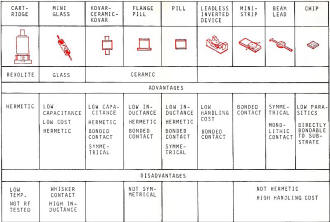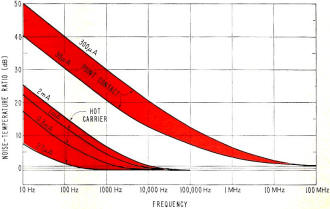|
July 1969 Electronics World
 Table of Contents
Table of Contents
Wax nostalgic about and learn from the history of early electronics. See articles
from
Electronics World, published May 1959
- December 1971. All copyrights hereby acknowledged.
|
My first exposure to
hot-carrier diodes
was in the detector sections of the s-band airport surveillance and x-band precision approach
radar systems I work on in the USAF. I had no idea what a hot-carrier diode - or for
that matter what a Schottky diode, its alternate name - was at the time. Come to think
of it, I do not recall them ever being referred to specifically as hot-carrier or Schottky diodes
- just "diodes." This Electronics World article from Hewlett Packard engineer
Stephen Adam provides some background into hot-carrier diodes, including how their low
barrier potential, small junction capacitance, low noise, and short recovery time makes
them ideal for high frequency operation. Our radar hot-carrier diodes had the cartridge
package style that loaded like a bullet into their holders.
This edition of Electronics World ran a series of diode articles:
Hot Carrier Diodes,
Variable-Capacitance Diodes,
Tunnel Diodes,
Microwave Power Diodes,
A Survey of Silicon
Junction Diodes, and
Light-Emitting Diodes.
Hot-Carrier Diodes

The author received his mechanical and electrical engineering training
in Budapest, Hungary and holds the equivalent of an M.S.E.E. He holds several patents
covering microwave devices and has three more pending. He has published several articles
in this field and is the author of a textbook on "Microwave Theory and Measurements"
to be published this year. Since 1961 he has been teaching his specialty at Foothill
College in California. He is president of the Bay Area Council for Electronics Education,
Inc. and is a member of the IEEE.
By Stephen F. Adam / Engineering Group Leader, Microwave Division, Hewlett-Packard
Company
These Schottky-barrier diodes, with their metal-semiconductor junctions, are used
as high-frequency mixers and detectors and for very high speed switching.
Semiconductors have been used in electronic equipment for decades. Point-contact diodes
were the first ones to be used in radio receivers and they are still widely used. in
high-frequency applications, for detecting and mixing r.f. signals. The development of
p-n junction diodes made possible improvements in many applications at sub-microwave
frequencies. Application of the Schottky theory to the metal-semiconductor junction produced
the hot-carrier diode, which became one of the most versatile, highly dependable semiconductor
devices used in modern electronics.

Fig. 1 - Switching characteristics of hot-carrier and "p-n" junction
diode with 1-ns recovery time. Signal is 30 MHz.

Fig. 2 - V-I characteristics of hot-carrier diode compared with the
1N21G point-contact microwave diode.
The hot-carrier (Schottky-barrier) diode features: non-linear resistance, no stored
charge, very short recovery time, ideal V-I characteristics, low barrier potential, low
flicker noise, high pulse power capability, good mechanical stability, and high breakdown
voltage. These features allow the hot-carrier diode to be used at microwave frequencies
and for very fast pulse switching. Picosecond switching is now possible. As microwave
detectors, hot-carrier diodes surpass other diodes in sensitivity and square-law characteristics
and unprecedented mixing characteristics have been reported. Greatly improved microwave
modulators and samplers have also been designed and constructed by using such diodes.
Essentially, the hot-carrier diode is a rectifying junction diode, where the junction
is formed by a metal and a semiconductor. Either n- or p-type silicon is used for the
semiconductor in junction with a variety of metals, such as gold, silver, platinum, or
palladium.
The operation of the hot-carrier diode, in contrast to the p-n junction diode, is
dependent on majority carrier conduction with virtually no storage of minority carriers.
Fig. 1 compares the switching characteristics of a hot-carrier diode and a high-speed
p-n diode having 1-ns recovery time. This illustrates the hot-carrier diode's superior
rectification efficiency at very high frequencies. Microwave point-contact diodes exhibit
similarly efficient rectification since at their point-contact a sharp metal whisker
provides the rectifying junction, which is essentially a Schottky barrier.
A comparison of the V-I characteristics of a point-contact microwave diode with a
hot-carrier diode clearly shows the superiority of the hot-carrier diode (Fig. 2). In
the point-contact diode, the metal-semiconductor junction is localized to a very small
point, which is like a hemispherical junction. The hot-carrier diode has a true planar
junction which provides uniform, repeatable contact potential and current distribution.
This structure gives a rugged, lower noise diode, with lower series resistance, which
is capable of handling higher power levels and is capable of withstanding larger transient
pulses. With forward bias, the electrons in the semiconductor override the barrier potential
and with great kinetic energy, or temperature, plunge into the metal, hence the name
"hot-carrier diode." As the barrier is reduced, then the amount of current flow in the
device increases from the semiconductor to the metal in an exponential manner.

Fig. 3 - Various packaging and encapsulating arrangements that are
used for presently available hot-carrier diodes.

Fig. 4 - The noise characteristics of a typical hot-carrier diode
is compared here with a typical point-contact diode at various operating currents.
If reverse bias is applied to the hot-carrier diode, only a few tenths of a millivolt
is sufficient to reduce current flow to a negligible value. The reverse current leakage
is constant until fairly large reverse voltages are applied, at which time, due to breakdown,
the current rises very rapidly. Avalanche multiplication causes this phenomenon.
A hot-carrier diode is made from a 0.020" X 0.020" heavily doped n+ silicon
substrate. An n--type epitaxial layer is grown on one side to a specific resistivity;
on the other side a metallic ohmic contact is provided. After thorough cleaning, metal
dots are deposited on the epitaxial surface to form a diode barrier. The size of dots
and their material is dependent upon the required electrical characteristics.
These chips are then mounted into their casings, the type depending upon the application.
Sometimes, for very critical applications, the chips themselves are bonded directly into
devices to minimize the effects of the casing at very high frequency or with very fast
pulses. Lately, a beam-lead configuration has been found to have excellent high-frequency
characteristics.
Great care has to be taken with these non-hermetically sealed diodes so as not to
damage them before they are placed into their mounts and then hermetically sealed. Furthermore,
special transmission-line-mounted diodes are available in stripline configurations. Many
types of encapsulation and packaging have been devised to enable the user to mount the
diodes in the most desirable fashion. Some of the typical forms are shown in Fig. 3.
In addition to single diodes, matched pairs and quads are also available. Quads are
marketed in pre-assembled, encapsulated form in bridge and ring configurations, or in
matched individual diode form to enable the user to verify the electrical characteristics
of the separate diodes.
Applications
Because of the nearly ideal electrical characteristics of hot-carrier diodes, a great
variety of applications is open for them. Extremely fast turn-on and turn-off characteristics
in the picosecond region, no charge storage, majority carrier conduction, low noise,
and uniform forward and reverse characteristics make them useful even at microwave frequencies.
Among the many uses of hot-carrier diodes, probably the most useful is for high-frequency
mixer and detector applications.
In most cases, a mixer is used for frequency translation to a lower frequency while
maintaining the information delivered by the high-frequency carrier. This is accomplished
by applying the r.f. input signal with the local oscillator's signal, to a nonlinear
resistor (the diode) . Due to the high level of the local oscillator signal, the nonlinear
element becomes a time-varying resistance. As a result, the difference of the two signals
will appear as an intermediate frequency which is proportional to the input r.f. signal
level and independent of the local oscillator signal level. In addition, the sum of the
signals will also appear if the mixer's bandwidth is able to carry it. The i.f. can range
anywhere up to several hundred MHz, or even a few GHz, depending upon the application.
The choice of the i.f. frequency and the mixer diode are basic contributions to the sensitivity
of the receiving system.

The HP 33801 series hot-carrier diode is shown here in a cutaway view
along with its mixer/detector mounting.
Typically, noise figures of hot-carrier diodes used as mixers are on the order of
6 to 6.5 with an impedance mismatch of 1.5:1 v.s.w.r. on the r.f. side. Fig. 4 shows
the noise characteristics of a hot-carrier diode. The reason for this lower noise behavior
of the hot-carrier diode is that it has a planar junction in contrast to the point-contact
diode's quasi-hemispherical junction, thereby providing a uniform contact potential.
Detectors are essentially low-sensitivity receivers, rectifying the r.f. signal through
a nonlinear resistor, a diode. Two kinds of detectors can be considered; small-signal,
low-level ones relying on the square-law characteristics of the V-I curve, and the high-level,
large-signal, or linear, peak detectors.
The small-signal detector operates near the bias point; the output signal voltage
is proportional to the input power, that is, the square of the input voltage. One of
the most important characteristics of such a detector is sensitivity. Sensitivity depends
upon how well both the r.f. input and the video output are matched. Rectification efficiency,
noise properties of the diode, and of course the noise figure, input impedance, and bandwidth
of the following amplifiers are also important contributing factors in determining over-all
sensitivity.
Conversion efficiency of hot-carrier diodes is quite small, consequently the sensitivity
of these diodes can be vastly improved by biasing them. Bias limitations arc set by the
i.f. noise characteristics of the diode and by the amplifier's noise properties. A trade-off
has to be reached when no more useful sensitivity can be obtained, due to increasing
noise generation.
Large-signal detection with diodes is dependent upon the slope of the V-I characteristic
in the linear portion of the curve. The diode conducts only over a portion of the input
cycle, consequently the output current follows only the peaks of the input signal, with
a linear relationship between input and output voltages.
Limiter-detectors built with hot-carrier diodes provide such features as: high sensitivity,
high burnout energy, low reflection, hybrid integrated-circuit structure, hermetically
sealed diode construction, and ultra-miniature size, making them useful for space applications.
Prices Now and in Future
Schottky's original work on metal-semiconductor junctions opened the door to many
experiments. In the early 1960's the "hot hole," "hot electron," "unipolar," and finally
the uniformly named "hot-carrier diode," made its debut. Although these diodes have only
been in use for the past 5 or 6 years, their desirable characteristics have led to a
great many applications.
Single diodes with extremely good characteristics can now be purchased for under $2.00.
Matched pairs cost less than $4.00 when purchased in small quantities. Matched quads,
unconnected, cost around $10.00. The ever-increasing usage and future technological advances
promise more price reductions for microwave hot-carrier diodes.
One of the most recent developments has been the hybrid hot-carrier diode, where the
p-n junction technology is combined with Schottky-barrier techniques. This device offers
higher reverse breakdown voltage and even higher speed operation.
Future applications in many areas, such as fast switching, sampling, waveform generation,
logarithmic conversion in the picosecond region, and modulation, are expected to increase
the usefulness of the hot-carrier diode.
Posted February 6, 2018














